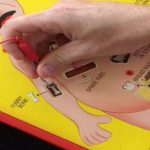 Music
Music  Music
Music  History
History 10 Less Than Jolly Events That Occurred on December 25
 Weird Stuff
Weird Stuff 10 Funny Ways That Researchers Overthink Christmas
 Politics
Politics 10 Political Scandals That Sent Crowds Into the Streets
 Weird Stuff
Weird Stuff Ten Bizarre Facts About The Doge Meme
 Our World
Our World 10 Ways Your Christmas Tree Is More Lit Than You Think
 Movies and TV
Movies and TV The 10 Coolest Stars to Set Sail on The Love Boat
 History
History 10 Things You Didn’t Know About the American National Anthem
 Technology
Technology Top 10 Everyday Tech Buzzwords That Hide a Darker Past
 Humans
Humans 10 Everyday Human Behaviors That Are Actually Survival Instincts
 Music
Music 10 Surprising Origin Stories of Your Favorite Holiday Songs
 History
History 10 Less Than Jolly Events That Occurred on December 25
 Weird Stuff
Weird Stuff 10 Funny Ways That Researchers Overthink Christmas
Who's Behind Listverse?

Jamie Frater
Head Editor
Jamie founded Listverse due to an insatiable desire to share fascinating, obscure, and bizarre facts. He has been a guest speaker on numerous national radio and television stations and is a five time published author.
More About Us Politics
Politics 10 Political Scandals That Sent Crowds Into the Streets
 Weird Stuff
Weird Stuff Ten Bizarre Facts About The Doge Meme
 Our World
Our World 10 Ways Your Christmas Tree Is More Lit Than You Think
 Movies and TV
Movies and TV The 10 Coolest Stars to Set Sail on The Love Boat
 History
History 10 Things You Didn’t Know About the American National Anthem
 Technology
Technology Top 10 Everyday Tech Buzzwords That Hide a Darker Past
 Humans
Humans 10 Everyday Human Behaviors That Are Actually Survival Instincts
10 Strange Physical Features You Didn’t Know You Had
African lungfish can survive for a year outside of water. Honey badgers don’t care about snake bites because they are venom-proof. Compared to the animal kingdom, humans are pretty boring, right? Not quite. Our species has traits that can appear downright bizarre or magical.
There is interoception, a sixth sense critical to our survival—yet few people know it exists. Secret stripes line our skin, and a living cloud follows us wherever we go. It gets weirder. From the fact that humans cannot feel wetness to children regrowing their fingertips, here are 10 reasons your physiology is more interesting than you think!
Related: 10 Medical Advancements That Increased Life Expectancy
10 Human Noses Can Follow a Scent Trail
It’s hard to imagine anyone tracking down a missing chocolate bar by putting their nose to the ground and following a scent trail like a bloodhound. Yet this is what neuroscientists at UC Berkeley made their students do.
In 2007, researchers dunked twine in chocolate essence and dragged the delicious-smelling rope across a field in a zigzag pattern. To ensure that volunteers would only use their sense of smell, they were blindfolded and fitted with noise-canceling earmuffs. Thus prepared, the students got down on all fours and began sniffing for chocolate.
The study confirmed the obvious (humans are worse than dogs at tracking) but also the surprising—we rapidly improve at following scent trails after a few weeks’ practice.
Even more intriguing was a 2017 study that suggested people could smell certain odors better than dogs. These scents include urine, flowers, bananas, and human blood. In theory, our noses could be attuned to them because they are crucial to human survival in some way, perhaps to alert us to food, wounds, or the health of others.[1]
9 A Lifespan Limit of 150 Years
In 2021, scientists dashed the hopes of many that immortality might be possible. After an in-depth study, they concluded that the lifespan of our species is seemingly capped at 150 years. Life expectancy in the U.S. is currently 74 for men and 80 for women. Although 150 is a vast improvement, it’s still not enough for those who want to live forever.
To discover the limits of our existence, researchers hunted for the point where the body could no longer repair itself after normal stresses like injuries or illnesses. They combed through the medical data of 544,398 volunteers and narrowed down an age bracket where the aging body cannot heal on its own due to the irreparable breakdown of biological elements. This failure point lies between 120 and 150 years.
The solution seems simple on paper. To push past this hard limit, humans need therapies that support the body’s ability to bounce back from stressors and stay resilient. However, the hard part is creating therapies that ensure a person’s health and quality of life (the latter is not always synonymous with old age) as they live decades beyond what we naturally would. [2]
8 Firefighters Are Heat Resistant
Some extraordinary human skills are not present at birth. They evolve out of necessity. One example involves firefighters. They regularly deal with blazes where temperatures can range from mild to hellish. In 2014, researchers discovered that firefighters can develop heat resistance. Even more impressive, this ability strengthens the longer they work in the industry.
The study compared two groups of men, all aged 51. One group consisted of veteran firefighters, while the rest were physically fit individuals with no experience running into burning buildings. All the volunteers had to perform the same tasks while exposed to intense temperatures. The test results showed that, physically, everyone experienced similar strain. However, only the non-firefighters found the exercise extremely exhausting and challenging.
The discovery that firefighters become heat-resistant could create more effective teams, where veterans deal with the brunt of an emergency and new firefighters follow once things are more under control. This might allow novice team members to gain experience and acclimatize to infernos at a safer pace.[3]
7 A Dormant Coat of Fur
Most pet owners have looked at their dog or cat and wondered, “Why do humans lack pelts?” Incredibly, humans can grow a full coat of fur. However, somewhere in antiquity, evolution decided to switch off our genes for a hairy suit. Should nature flick them back on, humankind can expect full-body tresses.
This discovery came to light in 2023 when the University of Pittsburgh combed through 370,000 genes and compared them across 62 mammal species. Part of the study was to understand the evolution of fur-free animals unrelated to each other (like humans, elephants, and dolphins).
The study found that, even though these species became hairless for different reasons, the same sets of genes were responsible. Over time, these genes gathered mutations that allowed elephants to lose hair for better temperature regulation and dolphins to move faster through the water. For humans, perhaps to get rid of parasites clinging to our fur, mutations switched off our genes for a full-body pelt.[4]
6 You’re Inside a Cloud (It’s Alive)
Every person lives inside an invisible bubble. Called the exposome, this cloud is home to micro-organisms like bacteria, fungi, bugs, viruses, and even chemicals.
This swarm is a mystery. Nobody knows how big exposomes are or what goes on inside. One reason for this confusion is the dynamic nature of the cloud’s content. The types of organisms and their quantities are constantly altered by changes in the person’s health, environment, exposure to chemicals, and more.
In 2018, a study strapped air monitors to the arms of 15 volunteers. The goal was to learn more about what lived inside their exposomes. The devices were designed to hoover the air around the participants as they went about their lives and collect particles for genetic and chemical analysis.
The study gathered a mind-boggling amount of data. However, despite 70 billion computer readouts and finding countless species and organisms, the ultimate discovery was perhaps an obvious one. The content of an exposome is unique to every person, consisting of “ingredients” drawn directly from their environment at home, work, and everywhere they go.[5]
5 A Sense Called Interoception
The five senses are well known. They include sight, touch, smell, hearing, and taste. You also have a sixth sense called interoception.
In a nutshell, interoception describes a person’s ability to feel and act upon internal signals. This sense exists to ensure that every system in the body works by alerting you when something might be out of balance. For example, thirst makes you reach for a glass of water, while cold makes you go indoors or put on a jacket.
Interoception is also critical to mental health, helping us to navigate psychological processes during social interactions and decision-making and to maintain emotional stability. Abnormal interoception has been linked to anxiety, eating disorders, and depression.
A lot of mystery still surrounds interoception, but experts agree that this often-forgotten sense is critical to all aspects of human health.[6]
4 We Don’t Feel Wetness
It seems so straightforward. A person enters the shower, opens the faucets, and instantly feels the water on their skin. However, this sensation is one of your brain’s greatest tricks. The truth is that nobody can feel wetness. Our skin lacks the receptors required to feel liquids directly.
Instead, our other senses blend to “feel” water. For example, our eyes see the water. The skin collects tactile information about pressure, movement, texture, and temperature.
The brain needs this data to distinguish between real wetness and the illusion of wetness—something that doesn’t always work. One instance where the brain gets it wrong is when you sit on a dry but cold metal chair. Some people legitimately believe they just sat down in a puddle of water.
So, why this confusion? Researchers believe that humans might’ve evolved to associate coolness with moisture and that we need our eyesight to differentiate between the two. Indeed, the majority of blindfolded volunteers in a 2013 study thought a dry probe touching their skin was wet if it measured 32 degrees Fahrenheit (0 degrees Celsius).[7]
3 Humans Have Secret Stripes
The human skin has epic markings. Called Blaschko lines, they are invisible to the naked eye, but these patterns include tiger-like stripes, swirls, blotches, and even geometric blocks.
Blaschko lines were discovered in the 20th century by Alfred Blaschko. As a dermatologist, he was keenly interested in skin health. During a study where he examined 150 people, Blaschko noticed a pattern. Literally. Most of his patients’ birthmarks, moles, rashes, and other skin conditions traced set paths across their bodies. These paths appeared as chest arcs, scalp spirals, swirling buttock loops, neck wriggles, and map-like contours across the back.
The patterns appear to be a quirky leftover from our time in the womb, marking the directions new cells took as our skin began to grow and expand. Other patterns, like large checkered blocks, are genetic and linked to the inheritance of one or both X chromosomes from our parents.
Blaschko lines are sometimes visible. Certain skin conditions, rashes, and skin pigment mutations can reveal these intriguing stripes and patches.[8]
2 We Have the Potential to Be Venomous
It sounds like science fiction, but humans have what it takes to become poisonous. While it’s unlikely that future quarrels between people might end with one delivering a venomous bite to the other, it’s still mind-blowing to realize just how close we are to this reality.
Venom glands are just saliva glands that have been modified to produce toxins. In poisonous creatures, these glands have genes that make a lot of proteins. This “protein factory” is crucial to support the entire venom system, as animals need plenty of proteins to produce poison promptly and in large quantities.
Similar genes exist in the human salivary gland. This organ not only produces proteins in large quantities, but it also secretes kallikreins. This specific protein is the most common ingredient in animal venom, and depending on the species, it can make a bite merely painful or fatal. For now, the dose of kallikreins in human saliva remains too low to inflict any harm.[9]
1 Kids Can Regrow Their Fingertips
A few years ago, an eight-year-old girl was rushed to the ER. Her middle finger had been sliced off above the nail cuticle. When a surgeon couldn’t find a vital vein needed to reconnect the tip, he just stuck the amputated piece back on and hoped for the best. The tip didn’t reattach, but that didn’t matter. A few weeks after the injury, the girl grew a new fingertip, bone and all.
Similar stories have been reported since the 1970s. All successful cases involved youngsters whose lopped-off fingers kept a piece of the nail or cuticle. Children who lost a larger portion of their fingers weren’t so lucky. Adults don’t regrow fingers, period.
For decades, the mechanics behind this process remained poorly understood. It wasn’t until 2013 that researchers finally figured out why the nail base was essential to spontaneous fingertip regeneration.
A study found that after mice’s toes were amputated, stem cells at the base of their fingernails sprung into action. They turned into busy cell factories intent on regrowing the claw tip. The stem cells also sent out a signal that encouraged bone and nerve growth. Interestingly, mice don’t seem to suffer from the same age restriction as humans, as even elderly rodents regrew their toe tips during the experiment.[10]








